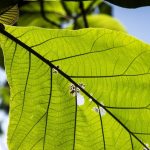
When I first started blogging about making homemade deodorant and other DIY projects, I never imagined I’d be talking passionately about why you should cut down Bradford Pear trees immediately, but here we are.
At first glance, these trees may seem appealing with their pretty white flowers, despite their strong odor. However, beauty doesn’t always equal good. While Bradford Pear trees won’t physically harm you like a wild animal or toxic flower, they are definitely a problem in other ways and have even been dubbed an environmental disaster.
To understand why these trees are trouble, it’s important to know their origins. Bradford Pear Trees originated from China and were introduced to the U.S. in 1964 by the Department of Agriculture as a decorative tree. They were thought to be sterile and are known for their weak branches. These trees typically only live around 20-25 years, as they are prone to damage in ice storms.
The main issue is that these trees aren’t sterile as assumed. They don’t pollinate among themselves but readily cross-pollinate with other plants, leading to serious ecological problems. This has resulted in a widespread invasion of pear trees, which morph into their ancient form, Callery pears. These aggressively form thorny thickets that choke out native trees like pines, maples, and oaks.
When you see fields of these white flowers, remember they’re not charming; they’re destroying nature. Callery pears have thorns that can destroy tractor tires and require heavy machinery to remove, costing up to $3,000 per acre. They may not seem harmful in your backyard, but they are wreaking havoc on farmland and native hardwoods, which is why I felt compelled to write about this.
Even reputable nurseries and landscapers steer clear of planting them. I’ve encountered Callery pears and felt their intimidating thorns firsthand. The Bradford Pears in your garden are cross-pollinating and exacerbating this issue.
We introduced these trees assuming they wouldn’t spread, but now they are overtaking native species, much like how Kudzu covers the South or Burmese Pythons encroach on the Everglades. Let’s address this problem—start by cutting them down.
Not only are they damaging native ecosystems and expensive to remove, but they also have other drawbacks:
– They’re structurally weak. Though admired for their symmetrical shape, Bradford Pear trees tend to break under light rain or wind and only last about 20 years.
– Grass struggles to grow under them, leaving bare, muddy patches.
– They grow much larger than intended, sometimes doubling in size and overwhelming small yards.
– And, they smell terrible, often compared to rotting fish.
All these negatives wouldn’t matter as much if they offered benefits like edible fruit—but they don’t. Originally bred to be sterile, they don’t produce fruit, just problems through cross-pollination.
Cities across the country are running campaigns advising against planting these trees, with some places like Pittsburgh banning them altogether. If you’re thinking about planting trees, consider healthier alternatives, and if you already have Bradford Pears, think about replacing them.
Removing them isn’t straightforward and requires extra effort beyond cutting them down. Now is a great time before they bloom, or in fall when you can plant new, beneficial trees. There are plenty of better tree options based on your garden needs. Your yard and local plant life will appreciate it.
Do you have any of these trees in your yard? Did you know about their negative impact?

